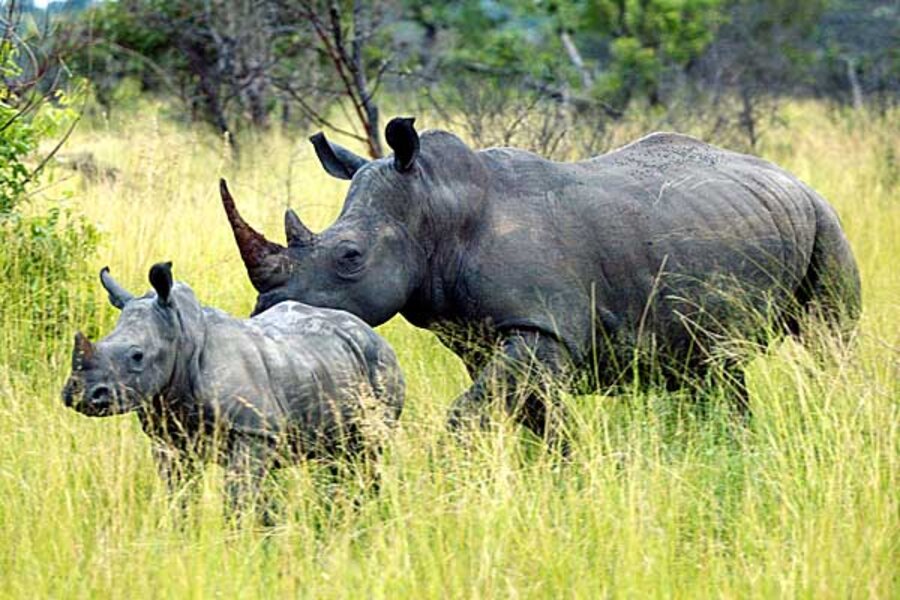Serengeti homecoming: yes, Black Rhinos can fly
Loading...
| Singita Grumeti Reserve, Tanzania
Six critically endangered mammals will begin the long flight home on Friday. These Eastern Black Rhinos will, for the first time, live in their native habitat in Tanzania, where their ancestors were evacuated from 46 years ago to save them from poachers.
Conservationists have called it the most ambitious wildlife relocation in East Africa in the past 50 years.
But large-scale transplant operations of African wildlife are becoming more common. Earlier this year, for example, Kenya rounded up 4,000 zebras and 3,000 wildebeest and trucked them across the country to restore the ecological balance after a drought in the Ambroseli National Park killed off 60 percent of the herbivores. About a decade ago, more than a dozen elephants were airlifted from Botswana (where there is a surplus) to Angola.
This time, three male and three female Eastern Black Rhinoceroses will be airlifted from South Africa (officials couldn't confirm any excess baggage fees) to the Serengeti National Reserve in northern Tanzania. But this is just the start of an ambitious rhino transplant program.
The Eastern Black Rhino is among just 188 mammals on the “red list” of endangered species of the International Union for the Conservation of Nature. Poaching during the 1960s and 1970s almost wiped the rhino out in its native East Africa. Scientists were convinced at the time that this black rhino sub-species would become extinct and flew seven rhinos to South Africa for their safety in 1964.
By 1991, only two Eastern Black Rhinos remained here in the Serengeti. Today, their numbers have rebounded to 33 in the Serengetti ecosystem, covering more than 5,700 square miles.
“This animal’s best chance of survival is in its natural habitat here in East Africa,” says Brian Harris, managing director of the Singita Grumeti Fund, which is paying the relocation project’s $6.8 million cost. “Rare and key species like this are critical to the biodiversity of this ecosystem, and the efforts put in place to ensure security for their return will clearly also help preserve the integrity of the whole Serengeti.”
What has become known as the Serengeti Rhino Repatriation Project began eight years ago. It has developed into a partnership between Singita Grumeti Reserves, the Frankfurt Zoological Society, and the Tanzanian National Parks Authority.
The project's focus so far has been on ensuring that the new home for the first six rhinos will be safe from poachers, and on training an elite force of 24 rangers to guard them.
26 more rhinos on order
Over the next two years, 26 more Eastern Black Rhinos will be moved from South Africa to the Serengeti National Park, one of Tanzania’s most visited parks, which borders Kenya’s Masai Nara National Reserve.
Conservationists calculate that there are fewer than 4,300 black rhinos left anywhere in the wild, down from peak population of 65,000 in the middle of the past century. Here in Tanzania, the addition of 32 black rhinos will almost double the population once this repatriation project is completed.
“It is the largest number of large animals moved the longest distance internationally in history,” says Alistair Nelson, program manager for the Frankfurt Zoological Society.
The rhinos, all young adults between the ages of 4 and 17, were six weeks ago captured from a private South African conservancy. All are descendants of the original seven taken to South Africa in 1964.
Since they were caught, they have been kept in large, fenced pens called bormas to familiarize them with being in enclosed spaces. Two expert rhino handlers have spent weeks introducing them to the crates, which will be used to carry them from South Africa to Tanzania.
Overnight Thursday, they will be ushered into those crates, mildly sedated, and loaded onto a chartered Hercules C-130 airplane for the five-hour flight to the dirt airstrip at Seronera in the Serengeti.
Once in Tanzania, they will again spend their first weeks in specially-constructed enclosures, before being released fully into the wild, in their natural habitat once again.
RELATED:





